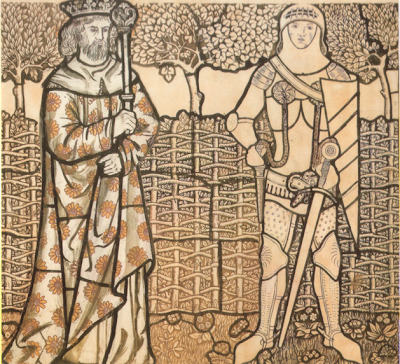Illustration: William Morris. Tristram and Isoude at the Court of King Arthur, 1862.
Morris, Marshall, Faulkner & Co which traded as Morris & Co after 1875, started life initially in 1861 largely as a supplier of ecclesiastical furnishings, in particular though not exclusively, stained glass. The market in mid-nineteenth century Britain for ecclesiastical stained glass was acute and very competitive. William Morris was in fact moving into territory that had already been requisitioned by some well-established, if recently so, companies that had a relatively comfortable history of supplying the lucrative ecclesiastical market with both vestments and furnishings.
Although religiously themed stained glass production was Morris, Marshall, Faulkner & Co.'s main concern, the company was also willing to supply a number of domestic commissions if called to. One of their earliest was a set of thirteen panels depicting the story of Tristram and Isoude. It was commissioned in 1862, only a year after the formation of the company by Walter Dunlop for his Harden Grange residence at Bingley in West Yorkshire.
Although Morris supervised the construction and placing of the thirteen stained glass panels, he was only creatively involved in three of the pieces directly. The other ten panels were divided up between Arthur Hughes, Dante Gabriel Rossetti, Val Prinsep, Edward Burne-Jones and Ford Madox Brown. These five artists efforts at Harden Grange will be covered in future articles of The Textile Blog.
Illustration: William Morris. Queen Guenevere and Isoude Les Blanches Mains, 1862.
Illustration: William Morris. Queen Guenevere and Isoude Les Blanches Mains cartoon, 1862.
Morris produced Tristram and Isoude at the Court of King Arthur, which is the first of the illustrations in this particular article. It shows Tristram and Isoude as well as King Arthur, a lady of the court and a harpist. It is said that Arthur in the extreme background is a self-portrait of William Morris, though whether this is true or mere fancy, is unknown. The panel itself is perhaps a little wooden and unimaginative as far as composition and narrative are concerned and certainly in comparison to some of the other panels by other artists. However, figurative artwork was never one or Morris strong points as he was more than willing to point out and the piece is competent and period based.
The two other pieces created by Morris are also included in this article along with their initial cartoons. They are entitled Queen Guenevere and Isoude Les Blanches Mains which simply shows both a static Guenevere and Isoude, while the last piece entitled King Arthur and Sir Launcelot shows both Arthur and Launcelot in equally static positions. These last two panels may appear to be the most unsatisfactory examples artistically as they are both static and lacking in any narrative. However, they are perhaps the closest to a form of medieval styled stained glass and are therefore in many respects the most successful if viewed from a medieval authenticity standpoint.
Illustration: William Morris. King Arthur and Sir Launcelot, 1862.
Illustration: William Morris. King Arthur and Sir Launcelot cartoon, 1862.
This was very early in Morris career and both the popular Gothic Revivalism along with his lifelong passion for forms of medievalism that, to be fair, were not always accurately interpreted, have obviously coloured this series of stained glass panels. This was by no means the last interpretation of Tristram and Isoude by this group of artists and certainly not the last interpretation of Arthurian legends by Morris, Marshall, Faulkner & Co or indeed William Morris. This early example of the work of both Morris and his successive businesses gives an insight as to the direction he and his company were to take for the rest of the nineteenth century. Although Morris was to expand his horizons from the initial appeal of the medieval, these interpretations through stained glass would always near the centre of his creative world and that of his later decorative achievements.
All thirteen of the stained glass panels were moved a short way down the road to the Bradford Art Gallery in 1917. That they still exist and will be celebrating their 150th anniversary in 2012 is both a miracle and a tribute to the Bradford Museums and Galleries department.
Further reading links:
The Stained Glass of William Morris and his Circle (Studies in British Art)
The Stained Glass Windows of William Morris and His Circle in Hampshire and the Isle of Wight (Hampshire Papers)
A guide to William Morris & Company stained glass in Great Britain
William Morris & Company stained glass in North America
British Stained Glass Artists and Manufacturers: William Morris, Augustus Welby Northmore Pugin, British and Irish Stained Glass
William Morris and Burne-Jones Stained Glass
Christopher Whall, 1849-1924: Arts and Crafts Stained Glass Worker - Catalogue of an Exhibition at the William Morris Gallery, London, 17th November, 1979-3rd February, 1980
Medieval Stained Glass in Suffolk Churches: "Let the Stained Glass Speak"
English and French Medieval Stained Glass in the Collection of the Metropolitan Museum of Art, New York (Corpus Vitrearum)
The Medieval Stained Glass of St Peter Mancroft, Norwich (Corpus Vitrearum Medii Aevi: Great Britain)
The Medieval Stained Glass of Wells Cathedral (Corpus Vitraearum Medii Aevi)
The Medieval Stained Glass of Cheshire (Corpus Vitrearum Medii Aevi)
Picturing the Celestial City: The Medieval Stained Glass of Beauvais Cathedral
Chartres Cathedral The medieval Stained glass and Sculpture
The Medieval Stained Glass of Northamptonshire (Corpus Vitrearum Medii Aevi: Great Britain)
The Medieval Stained Glass of Lancashire (Corpus Vitrearum Medii Aevi: Great Britain)
Studies in Medieval Stained Glass and Monasticism
The Medieval Stained Glass of South Yorkshire (Corpus Vitraearum Medii Aevi, Great Britain, 7)
The County of Oxford: A Catalogue of Medieval Stained Glass (Corpus Vitrearum Medii Aevi, Great Britain -- Volume 1).
Medieval Stained Glass
Medieval Stained Glass...Lincolnshire (Corpus Vitrearum Medii Aevi: Great Britain)




